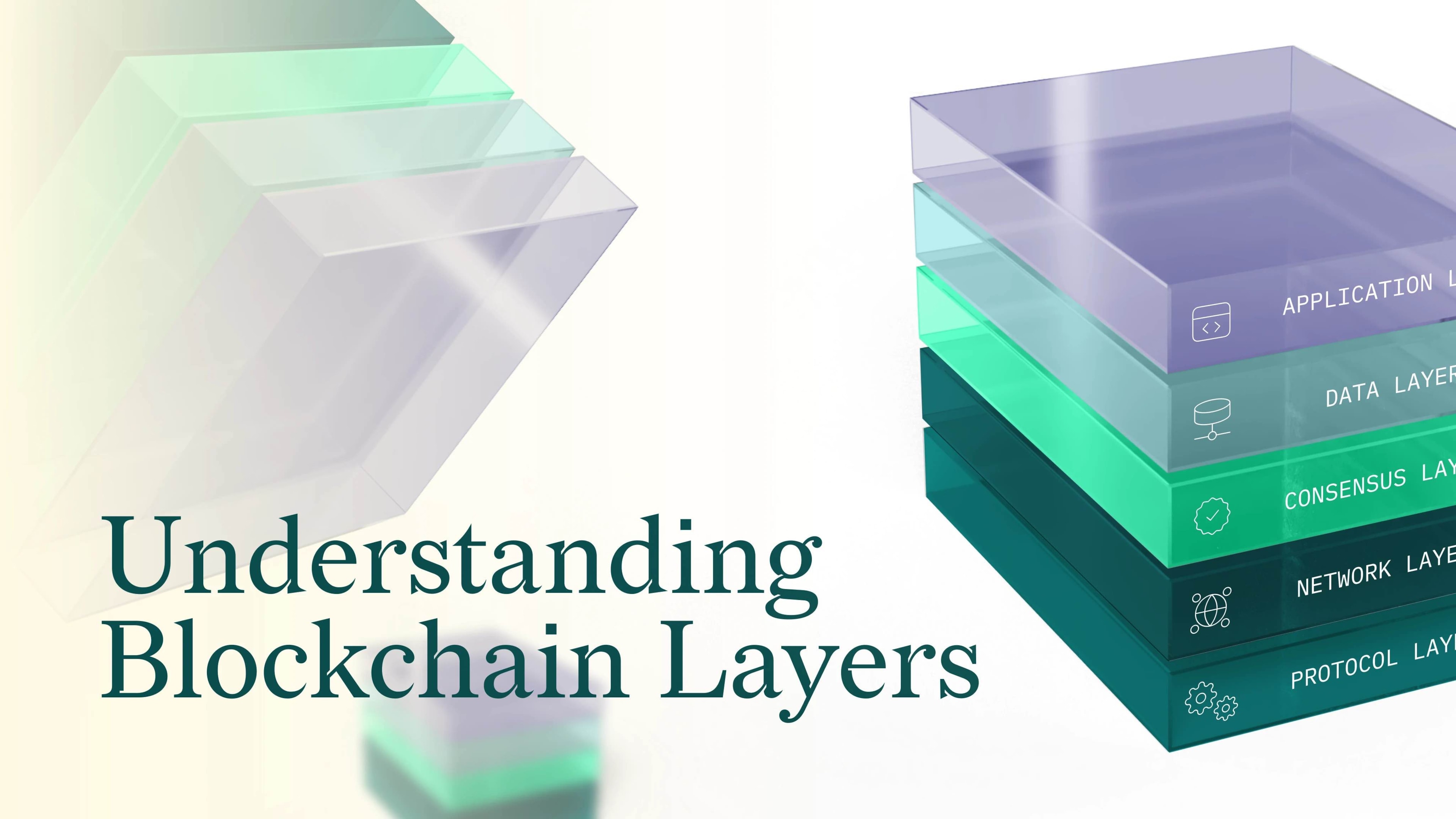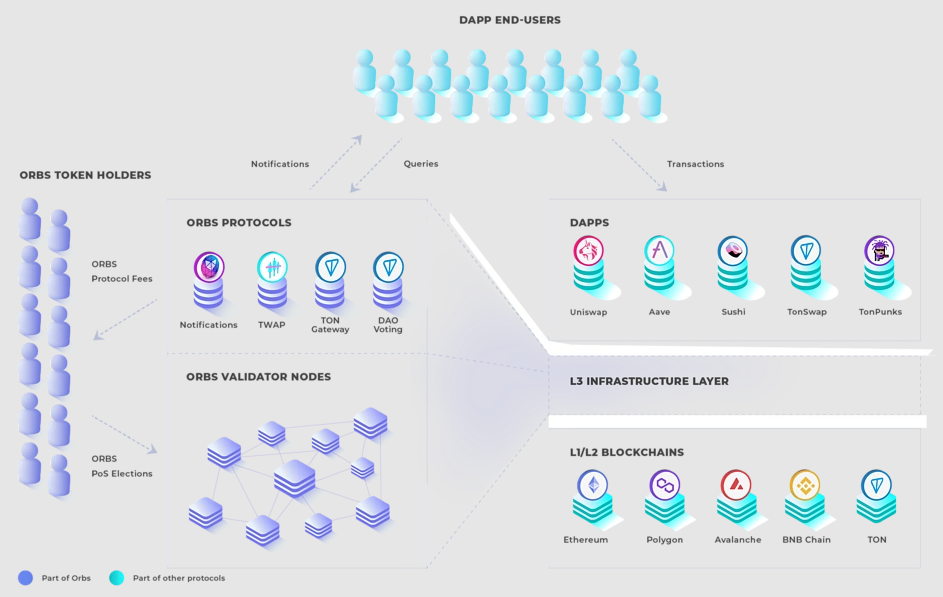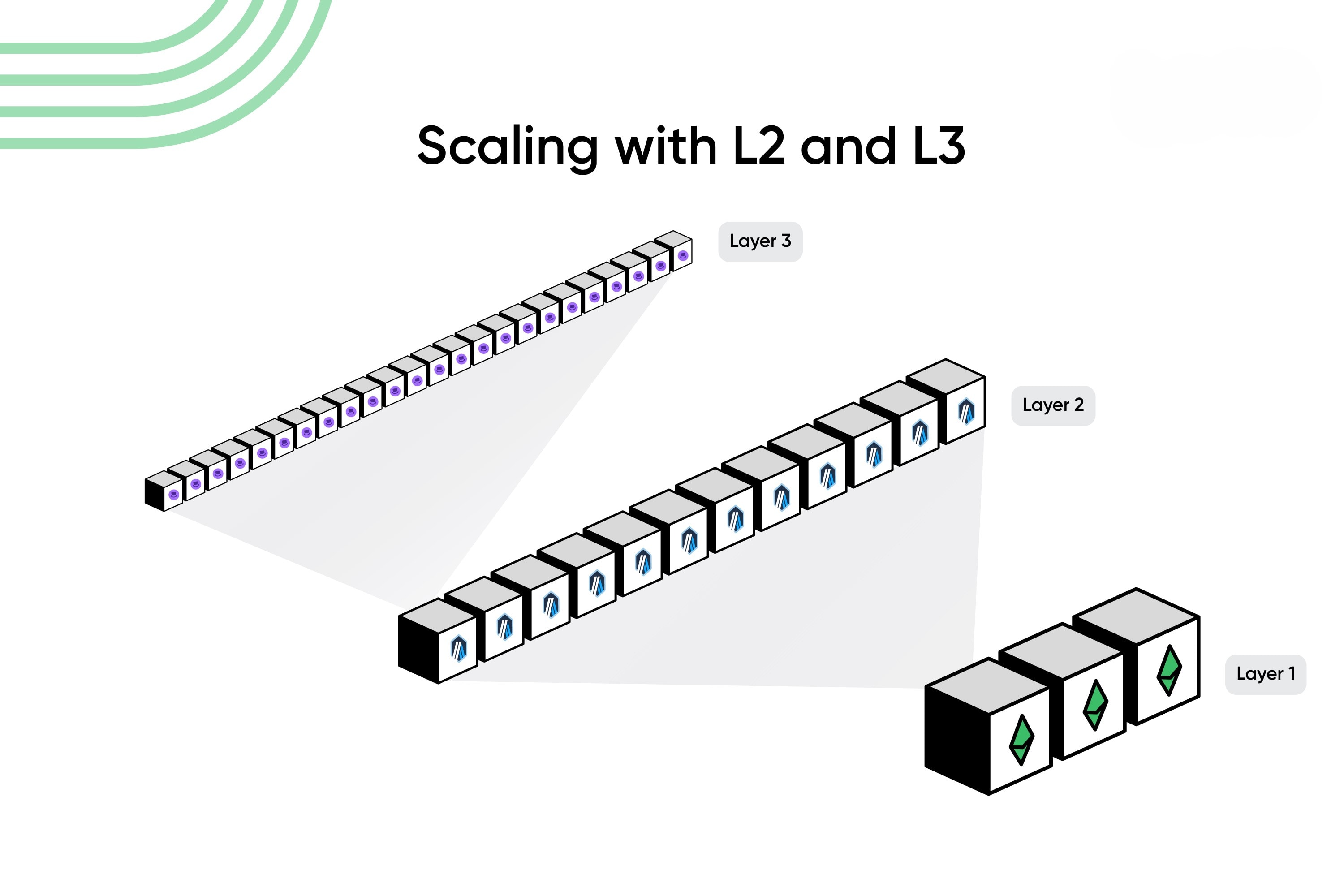Understanding Whats Layer 3 in Crypto: Everything You Need to Know
“Whats Layer 3 in crypto? Everything you need to know” is a topic that has gained attention as Layer 3 hosts DApps and enhances blockchain usability. Unlike Layers 1 and 2, Layer 3 focuses on user experience, scalability, and interoperability. In this article, you’ll learn everything you need to know about Layer 3’s benefits, features, and use cases.
Key Takeaways
- Layer 3 blockchains focus on user-facing applications and protocols, significantly enhancing scalability, interoperability, and user experience compared to Layer 1 and Layer 2 blockchains.
- Key features of Layer 3 blockchains include improved transaction processing capabilities, extensive customization options, and seamless communication between different blockchains, making them ideal for high-transaction and specialized application environments.
- Prominent Layer 3 projects such as Orbs, Arbitrum Orbit, and zkSync Hyperchains demonstrate the potential of this layer to revolutionize various sectors, including gaming, decentralized finance (DeFi), and cross-chain interoperability.
Introduction
Layer 3 in blockchain networks is where the magic happens. Decentralized applications (DApps) and the protocols that power them are hosted on a specialized network layer. This infrastructure allows for the development and deployment of a wide range of innovative applications. Unlike its predecessors, Layer 3 is not just about enhancing the underlying infrastructure but about making blockchain technology more accessible and user-friendly. By focusing on user-facing applications, Layer 3 aims to solve some of the most pressing issues in blockchain today, such as scalability and interoperability.
The role of Layer 3 is vital for the future of blockchain. It enhances user experience by creating applications that are both intuitive and efficient. Moreover, Layer 3 networks aim to bridge the gaps between various blockchains, creating a unified and robust ecosystem that can support a wide range of applications. This makes blockchain technology not only more powerful but also more practical for everyday use.
What is a Layer 3 Blockchain?

Layer 3 blockchains are specialized networks that host decentralized applications (DApps) and the protocols that enable them. These blockchains focus on creating user-facing applications and protocols on top of the existing blockchain infrastructure. This layer is essential for the future of blockchain due to its potential to drive innovation and wider adoption, making blockchain technology more accessible and efficient. By understanding the concept of blockchain layers, we can better appreciate the importance of layer 3 blockchains in the development of decentralized applications.
One of the primary goals of Layer 3 blockchains is to enhance user experience, scalability, and interoperability. By optimizing for these features, Layer 3 aims to solve some of the most pressing issues in the blockchain ecosystem today. For instance, by providing a more user-friendly interface and faster transaction speeds, Layer 3 makes it easier for developers and users to interact with blockchain technology.
Moreover, Layer 3 blockchains play a crucial role in bridging the gaps between various blockchains, creating a unified and robust ecosystem capable of supporting a diverse range of applications. Some key benefits of Layer 3 blockchains include:
- Enabling cross-chain interoperability
- Enhancing the functionality of existing blockchain platforms
- Bringing a new level of efficiency and usability to the blockchain space
Key Features of Layer 3 Blockchains
Layer 3 blockchains offer several key features that set them apart from their predecessors. One of the most significant is improved scalability. By hosting a single application and optimizing it for specific needs, Layer 3 can handle a larger volume of transactions more efficiently than Layer 1 or Layer 2. This makes them ideal for high-transaction environments, where performance and speed are critical. Some of the key features of Layer 3 blockchains include:
- Improved scalability
- Enhanced performance and speed
- Optimized for specific needs
- Ideal for high-transaction environments
Another key feature of Layer 3 blockchains is their unparalleled customization options. Developers can create highly specialized applications tailored to specific industries or use cases, offering a level of versatility and innovation that was previously unattainable. Additionally, Layer 3 enhances interoperability by facilitating seamless communication between different decentralized applications through standardized protocols and interfaces. This not only improves accessibility but also fosters a more connected and efficient blockchain ecosystem.
How Layer 3 Differs from Layer 1 and Layer 2

Layer 1 is the foundational layer of the blockchain ecosystem, providing the base infrastructure, immutability, and robust security. Examples of Layer 1 blockchains include Bitcoin and Ethereum, which have their own native tokens, consensus mechanisms, and smart contract capabilities. However, these blockchains face significant scalability challenges as the number of users increases, leading to higher transaction costs and slower processing times.
Layer 2 solutions are built on top of Layer 1 to address these scalability issues. They rely on Layer 1 for security and finality but improve transaction throughput and reduce costs by conducting certain transactions off the main chain. Examples include sidechains and off-chain transactions.
In contrast, Layer 3 builds on the improvements of Layer 2 but focuses on user-facing applications and specialized functionalities. It enables:
- Seamless communication between various blockchains
- Facilitation of more complex applications
- Transcending the limitations of scalability
- Enhancing interoperability.
Benefits of Layer 3 Blockchains
Layer 3 blockchains offer numerous benefits that make them an attractive option for developers and users alike. One of the primary advantages is the optimization of consensus mechanisms and data structures, which enhances transaction processing capabilities and throughput. This improvement in transaction speed makes Layer 3 blockchains more efficient at handling high transaction volumes, reducing fees, and improving overall performance. Some of the key benefits of Layer 3 blockchains include:
- Enhanced transaction processing capabilities
- Increased throughput
- Reduced fees
- Improved overall performance
Another significant benefit is the enhanced user experience. By focusing on user-facing applications, Layer 3 blockchains improve the interface and interaction between users and the blockchain, making it more accessible and user-friendly. This is crucial for driving wider adoption and making blockchain technology more practical for everyday use.
Moreover, Layer 3 blockchains offer extensive customization options, allowing developers to tailor environments for specific applications. This versatility fosters innovation and enables the creation of more sophisticated and specialized decentralized applications (DApps) on a scalable blockchain infrastructure.
Enhanced privacy features further add to the attractiveness of Layer 3 blockchains, addressing one of the critical concerns in blockchain usage.
Enhanced Scalability
Layer 3 enhances scalability by:
- Leveraging Layer 2 solutions to deliver enhanced scalability
- Optimizing for specific application needs
- Offloading tasks from Layer 1 and Layer 2
- Handling a larger volume of transactions more efficiently
- Using advanced protocols and optimization techniques that focus on scalability and performance.
The adoption of Layer 3 solutions is predicted to accelerate the widespread use of blockchain technology by improving scalability and transaction speeds. This enhanced scalability is expected to drive greater adoption and make blockchain applications more practical for a broader range of use cases, further solidifying the role of Layer 3 in the blockchain ecosystem.
Improved Interoperability

Layer 3 improves interoperability by facilitating seamless communication between different decentralized applications (DApps) through standardized protocols and interfaces. This enables smooth interaction and data exchange across multiple blockchain platforms, enhancing the overall functionality and accessibility of the blockchain ecosystem.
Enhanced interoperability provided by Layer 3 protocols allows for seamless asset and data transfers between different blockchain networks, addressing one of the major challenges in the blockchain space and enabling seamless communication. This increased interoperability is expected to drive greater adoption and foster a more connected and efficient blockchain ecosystem.
Customization and Flexibility
One of the standout features of Layer 3 blockchains is their ability to offer extensive customization options. Developers can introduce application-specific mechanisms, customize the governing rules, and choose which tokens to accept for transaction fees. This level of customization not only enhances the overall user experience but also allows for the development of highly specialized applications tailored to specific industries or use cases.
Layer 3 protocols are extensively used for creating non-fungible tokens (NFTs) and decentralized autonomous organizations (DAOs), showcasing the versatility and innovation potential of this layer. By optimizing the performance of decentralized applications with tailored rules and protocols, Layer 3 solutions support a wide range of complex, customizable DApps that can cater to various user needs and preferences.
Use Cases of Layer 3 Blockchains
Layer 3 blockchains have a wide array of use cases, making them an essential component of the blockchain ecosystem. These use cases include gaming applications, decentralized finance (DeFi) platforms, and cross-chain interoperability solutions. Each of these areas benefits uniquely from the advanced features and capabilities of Layer 3 blockchains.
In the gaming industry, Layer 3 blockchains provide a dedicated environment that ensures faster transaction speeds and cost efficiency, significantly enhancing the gaming experience for users. On the other hand, DeFi applications leverage Layer 3 protocols to offer customizable smart contracts, better transaction speeds, and enhanced privacy settings, driving innovation in financial services. Additionally, Layer 3 plays a crucial role in cross-chain interoperability, enabling seamless interaction and data exchange across multiple blockchain platforms.
These diverse use cases demonstrate the adaptability and potential of Layer 3 blockchains to revolutionize various sectors within the blockchain industry.
Gaming Applications
Gaming applications stand to gain significantly from Layer 3 blockchains. By operating on a dedicated blockchain, these applications can:
- Handle a larger volume of transactions at faster speeds
- Maintain cost efficiency for users
- Ensure that gaming applications are not bogged down by network congestion
- Provide a smoother and more enjoyable user experience
Projects like Axie Infinity and the Xai network are prime examples of how Layer 3 technology is being leveraged to deliver immersive gaming experiences. These platforms utilize the advanced capabilities of Layer 3 to create engaging, interactive games that attract a broad audience and foster a thriving gaming community.
Decentralized Finance (DeFi) Applications

Layer 3 blockchains are making waves in the decentralized finance (DeFi) sector by offering customizable smart contracts and enhanced privacy settings. DeFi platforms like Uniswap and Compound leverage Layer 3 protocols to provide more sophisticated financial services tailored to user needs. These customizable smart contracts enable DeFi applications to offer unique features and functionalities that cater to a diverse range of financial activities.
Moreover, Layer 3 DeFi applications benefit from better transaction speeds and reduced fees, making them more efficient and accessible to users. The advanced functionalities provided by Layer 3 solutions are driving innovation in the DeFi space, paving the way for new and exciting financial products and services.
Cross-Chain Interoperability Solutions
One of the most compelling use cases for Layer 3 blockchains is their ability to enable cross-chain interoperability. Layer 3 protocols facilitate seamless interaction and data exchange between different blockchain platforms, addressing one of the major challenges in the blockchain ecosystem. This interoperability is crucial for creating a more connected and efficient blockchain network.
Examples of Layer 3 projects that focus on cross-chain interoperability include Polkadot parachains like Clover Finance and Astar, which are designed to provide scalability and interoperability within the Polkadot ecosystem. Another notable example is Moonbeam, a Polkadot parachain that specializes in providing smart contract capabilities and Ethereum compatibility. These projects highlight the potential of Layer 3 blockchains to bridge the gaps between various blockchain networks, enhancing overall functionality and accessibility.
Challenges and Opportunities for Layer 3 Blockchains
While Layer 3 blockchains offer numerous benefits, they also face several challenges. Scalability remains a core issue that Layer 3 blockchains aim to tackle by building on top of existing Layer 2 solutions to further enhance transaction throughput. Additionally, adoption barriers such as technological complexity and a lack of standardized protocols can hinder integration and interoperability.
Despite these challenges, Layer 3 blockchains present significant opportunities for innovation. By enabling the creation of more sophisticated and customized decentralized applications, Layer 3 can drive the development of new concepts and functionalities. This innovation potential is particularly exciting for developers looking to:
- Push the boundaries of what is possible with blockchain technology
- Explore new use cases and applications
- Improve scalability and performance
- Enhance privacy and security features
Security Concerns
Security concerns are a critical consideration for Layer 3 blockchains. Robust security measures are essential as each decentralized application operates on its own network, making it vulnerable to various attacks. Ensuring protection against vulnerabilities and auditing smart contracts are vital for maintaining network security.
Layer 3 blockchains must address the risk of smart contract vulnerabilities and other security threats, such as IP spoofing and denial-of-service (DoS) attacks. By incorporating advanced consensus mechanisms and secure communication protocols, Layer 3 solutions can achieve higher throughput without compromising security.
Adoption Barriers
Adoption barriers for Layer 3 blockchains include technological complexity and the lack of standardized protocols. These challenges can make it difficult for developers and users to integrate and navigate the multi-layer ecosystem effectively. Moreover, the network effect of established Layer 1 blockchains can pose a significant hurdle for the widespread adoption of Layer 3 solutions.
To overcome these barriers, there is a need for education among developers and users about the benefits and functionalities of Layer 3 blockchains. By increasing awareness and understanding, the blockchain community can drive greater adoption and integration of Layer 3 technologies.
Innovation Potential
The innovation potential of Layer 3 blockchains is immense. By allowing developers to iterate and deploy updates more rapidly, Layer 3 fosters faster innovation and the development of new concepts and functionalities. This flexibility is crucial for keeping pace with the evolving demands of the blockchain ecosystem.
Moreover, the ability to customize application protocols and consensus mechanisms in Layer 3 networks enables unique user experiences and novel functionalities. This customization potential makes Layer 3 blockchains a playground for developers, encouraging experimentation and the creation of innovative decentralized applications on a decentralized network.
Examples of Prominent Layer 3 Projects
Several prominent Layer 3 projects are making significant strides in the blockchain industry. Notable examples include Orbs, Arbitrum Orbit, and zkSync Hyperchains. These projects showcase the diverse applications and capabilities of Layer 3 blockchains, each bringing unique features and functionalities to the table.
For instance, Orbs enhances smart contract capabilities and works seamlessly with various blockchain networks. Arbitrum Orbit enables the creation of customizable Layer 2 or Layer 3 chains within the Arbitrum ecosystem, providing developers with advanced tools for scalability and lower transaction costs. Meanwhile, zkSync Hyperchains focus on enhancing scalability and interoperability within the Ethereum ecosystem, offering seamless transfers of liquidity and other interactions between protocols.
Orbs
Orbs is a Layer 3 blockchain infrastructure project that aims to bridge the gap between Layer 1 and Layer 2 by enhancing smart contracts’ capabilities. It provides improved performance for decentralized applications (DApps) through its Layer 3 infrastructure, making it an attractive option for developers looking to optimize their DApps.
Orbs introduces innovative protocols such as dLIMIT, dTWAP, and Liquidity Hub, and offers a decentralized serverless cloud function called Orbs Lambda. This event-driven function enables the deployment of code executed by network validators. The ORBS token is the only means of payment within the Orbs platform, calculating commissions for applications and incentivizing validators.
Orbs works with multiple blockchain networks, including Ethereum, TON, Polygon, BNB Chain, Avalanche, and Fantom.
Arbitrum Orbit
Arbitrum Orbit brings a pivotal innovation to the blockchain space, offering a new pathway for launching chains within the Arbitrum ecosystem. This innovation is set to make a significant impact in the industry. It allows the creation of customizable Layer 2 or Layer 3 chains that can settle to other Layer 2 chains like Arbitrum One, providing advanced scalability and lower transaction costs.
Arbitrum Orbit offers developers tools to create their own Layer 3 blockchains with minimal approval requirements, making it a user-friendly and accessible platform for blockchain innovation. This vision for Layer 3 blockchains includes even lower transaction costs, enhanced scalability, and the ability for developers to create self-managed specialized blockchains.
zkSync Hyperchains
zkSync Hyperchains are a new tier of blockchain technology designed to enhance scalability and interoperability within the Ethereum ecosystem. These Layer 3 blockchains are powered by the zkEVM engine, which provides settlement and interoperability within the wider blockchain ecosystem.
zkSync Hyperchains aim to solve scalability and interoperability challenges in existing blockchain infrastructures, enabling seamless and nearly instant transfers of liquidity and other interactions between protocols within the system. They offer three data availability options: ZK rollup for full Ethereum security, zkPorter for a mix of on-chain and off-chain data, and Validium for ultimate performance.
Future of Layer 3 in the Crypto Industry

Layer 3 protocols are expected to play a key role in the evolution of blockchain technology, significantly shaping the future of blockchain networks by enhancing modern networking infrastructure and connectivity. As Layer 3 evolves, it is expected to transform user experience, making blockchain applications more adaptable and accessible to the general public.
The development of Web 3.0 crypto coins like Internet Computer (ICP) and Chainlink (LINK) is closely tied to the advancements in Layer 3 protocols, highlighting their importance in the broader blockchain ecosystem. As these protocols continue to mature, they are likely to drive greater adoption and integration of blockchain technology across various sectors.
Trends to Watch
One emerging trend in the Layer 3 space is the emphasis on enhancing user experience through better interfaces and interactions. This focus on usability is crucial for making blockchain technology more accessible and practical for everyday use, driving wider adoption and fostering a more connected blockchain ecosystem.
Predictions for Adoption
Layer 3 protocols are poised to play a central role in the evolution of blockchain technology. With their ability to enhance scalability, interoperability, and user experience, Layer 3 blockchains are expected to become a key feature in the blockchain ecosystem, driving widespread adoption and integration across various industries.
Summary
In summary, Layer 3 blockchains represent a significant advancement in the blockchain ecosystem. By focusing on user-facing applications, enhancing scalability, and improving interoperability, Layer 3 blockchains are poised to drive innovation and wider adoption of blockchain technology. They offer numerous benefits, including optimized consensus mechanisms, better user experience, extensive customization options, and enhanced privacy features.
Looking ahead, the future of Layer 3 in the crypto industry is promising. With ongoing developments and the potential for greater adoption, Layer 3 blockchains are set to transform the way we interact with and utilize blockchain technology. As these protocols continue to evolve, they will play a crucial role in shaping the future of the blockchain ecosystem.
Frequently Asked Questions
What is a Layer 3 blockchain?
A Layer 3 blockchain is a specialized network designed to host decentralized applications (DApps) and their protocols, prioritizing user experience, scalability, and interoperability.
How does Layer 3 differ from Layer 1 and Layer 2?
Layer 3 builds on the foundational infrastructure and improvements of Layers 1 and 2 to focus on user-facing applications and specialized functionalities.
What are some key features of Layer 3 blockchains?
Layer 3 blockchains offer improved scalability, enhanced interoperability, extensive customization options, and cost efficiency. All of these features make them attractive for various use cases.
What are some use cases of Layer 3 blockchains?
Layer 3 blockchains can be used in various applications such as gaming, DeFi platforms, and cross-chain interoperability solutions, offering a versatile range of possibilities for different industries.
What are the challenges and opportunities for Layer 3 blockchains?
Layer 3 blockchains face challenges in scalability, adoption barriers, and security concerns, but they also present opportunities for innovation and the creation of more sophisticated decentralized applications. Therefore, it’s crucial to address these challenges and leverage the opportunities for advancement.

